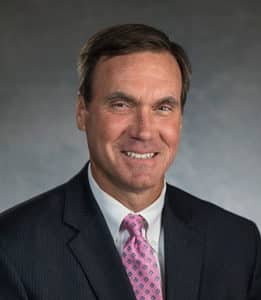Wells Fargo Invests in Automated Underwriting, Dealer Relationships to Boost Growth

After 18 months of tightening the reins, Wells Fargo Auto is on a growth trajectory, with a focus on investments to automate credit decisioning, Jerry Bowen, executive vice president and head of dealer relationships and product, told Auto Finance Excellence.
“We got a lot of the work that needed to be done in the rearview mirror,” Bowen said. “We are very focused on growing this business. We think 2019 is the year we will see that.” The bank’s auto loan outstandings fell 15.6% to $45.1 billion at yearend 2018, though originations started to tick up in the latter part of the year.
Bowen spoke with AFE about his broad focus on dealer customers, how the bank is managing the digital evolution, and why increasing vehicle prices are a top concern for 2019. What follows is an edited version of Bowen’s conversation with AFE.
Auto Finance Excellence: How are Wells Fargo’s dealers responding to digital advances?
JB: A group of our team members met with a large dealer customer recently and asked what the dealership’s challenges are. It was eyeopening when the dealer said that the number of leads coming in through the internet is around 1,000 a week. They’re trying to figure out how to deal with that. In a digital world, it’s hard to understand the difference between a true lead and someone just browsing the internet. You have to engage each one of those leads as if it’s a real opportunity and in a professional manner. The thing that stuck with me was that the dealer’s sales team said the success rate of converting those leads to actual sales is 10%.
AFE: How should dealers navigate those digital leads?
JB: One of the more underrated innovations in auto finance is managing leads in the digital world. Dealers and lenders that can most effectively utilize the data available and manage those potential referrals that are coming in digitally are going to be more successful than the rest of the pack. For dealers getting thousands of leads a week, imagine if they could move the 10% success rate to 15%. That’s a tremendous opportunity.
Our dealers are spending a lot of resources making sure we are positioning ourselves the way the market is, which is more digital. The ability to be effective at building relationships and using the tools digital offers you gives you a chance to differentiate yourself in the marketplace. From what I’ve seen, dealers are investing heavily in this.
AFE: In what technology has Wells Fargo been investing?
JB: We’ve been investing in automating our credit-decisioning process. When a dealer sends us the application, we want to have the work already done by our credit team so the application gets auto-decisioned. That’s not to mean we don’t put an emphasis on our underwriters, because they play a tremendous role. It makes more sense to let our underwriters spend their time on deals that take knowledge and insight, and more thought in the gray area of a transaction.
We’ve invested heavily in improvements to speed things up. We’re looking at e-contracting, e-funding, and removing the manual process that creates a slowdown. It makes us more consistent, rings out some of the costs, makes us more competitive, and keeps up efficiencies.
AFE: What are your priorities for Wells Fargo Auto in 2019?
JB: For 2019 we are focused on making Wells Fargo easier to do business with. We understand that speed is crucial. We know dealers have a consumer sitting on the other side of that equation and they want to give that consumer a good experience. If the process is elongated and bumpy, that’s not good for the dealer or the consumer. We are focused on continuing to do the things we’ve invested in to make ourselves faster.
AFE: What are some of the market headwinds on your radar?
JB: Affordability of new vehicles is becoming a bit of a challenge. The average new-vehicle price is about $35,000. We start to see consumers contemplate more late-model used cars, so affordability is an issue that is a challenge the industry has to work through. On the commercial side, some of our dealers are working with inventory levels that are becoming a concern from an expense standpoint.
We’ve had several increases in interest rates, and we’ve operated for years since the financial crisis in a zero-interest-rate environment. If new-vehicle sales are going to slow down, we need to make sure our dealers aren’t carrying too much inventory. We are starting to see dealers raise concerns and talk with us about focusing on inventory management.
The third challenge is re-engaging with our dealer body and repositioning our businesses for growth. There is an opportunity to go back with our dealer partners and connect, to make sure they know we are still here in the space. We tell them about all the work we’ve done by transforming the business and let them know the benefits.
AFE: What lessons do you take from your 30-year career with Wells Fargo and how do you apply those lessons learned today?
JB: The need to be customer-centric and the ability to think about life through the customer’s eyes. Customer-centricity is always something that has stuck with me, and I try to learn through the different roles I’ve had with the bank. Also, the ability to adapt to change. The banking industry is going through a tremendous amount of change.
If I think about what banking looked like when I first got started, it’s hard even to recognize that today. To be able to change with the industry and keep the focus on the career customers and what your customers are doing from a change standpoint is critical. The last thing is the need to learn continuously. I don’t care where you are in the stage of your career or what role you have, if you stop learning then you are done. You have to challenge yourself to learn to become a better leader while becoming more effective in servicing your customers.
This interview was originally featured in the March issue of Auto Finance News, out now.















